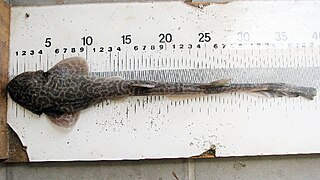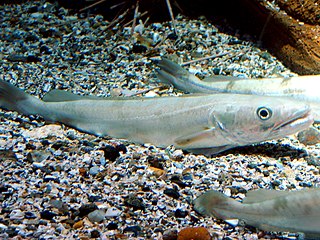
The term hake refers to fish in the:

The North Pacific hake, Pacific hake, Pacific whiting, or jack salmon is a ray-finned fish in the genus Merluccius, found in the northeast Pacific Ocean from northern Vancouver Island to the northern part of the Gulf of California. It is a silver-gray fish with black speckling, growing to a length of 90 cm (3 ft). It is a migratory offshore fish and undergoes a daily vertical migration from the surface to the seabed at depths down to about 1,000 m (3,300 ft). It is the object of an important commercial fishery off the West Coast of the United States, and annual quotas are used to prevent overfishing.
The scaly dragonfish or boa dragonfish, is a medium-sized abyssal barbeled dragonfish of the family Stomiidae. It is found at great depths worldwide in tropical to temperate oceans but is absent from the northern Pacific and northwest Atlantic Oceans.

The silver hake, Atlantic hake, or New England hake is a merluccid hake of the genus Merluccius, found in the northwest Atlantic Ocean. It is highly predatory and typically feeds on fish and crustaceans.

The Izak catshark or simply Izak is a species of catshark, belonging to the family Scyliorhinidae, common off the coasts of South Africa and southern Namibia. It typically inhabits the outer continental shelf at depths of 100–300 m (330–980 ft), with the males found deeper than the females and juveniles. The Izak catshark has a short, wide, flattened head and a robust body tapering to a long, slender tail. It can be identified by its ornate color pattern of dark brown spots or reticulations and blotches on a light yellowish background, as well as by the enlarged dermal denticles over its pectoral fins and along its dorsal midline from the snout to the second dorsal fin. This species reaches 69 cm (27 in) in length, with the males larger than females.
Sepia australis, the southern cuttlefish, is a species of cuttlefish which is found in the eastern South Atlantic Ocean and the western Indian Ocean off the coasts of Southern Africa, possibly extending into the waters off East Africa.

Mullus barbatus is a species of goatfish found in the Mediterranean Sea, Sea of Marmara, the Black Sea and the eastern North Atlantic Ocean, where its range extends from Scandinavia to Senegal. They are fished, mostly by trawling, with the flesh being well regarded. The International Union for Conservation of Nature has assessed their conservation status as being of "least concern".

Merluccius is a genus of merluccid hakes from the Atlantic and Pacific Oceans, where mainly found relatively deep.

The European pilchard is a species of ray-finned fish in the monotypic genus Sardina. The young of the species are among the many fish that are sometimes called sardines. This common species is found in the northeast Atlantic, the Mediterranean, and the Black Sea at depths of 10–100 m (33–328 ft). It reaches up to 27.5 cm (10.8 in) in length and mostly feeds on planktonic crustaceans. This schooling species is a batch spawner where each female lays 50,000–60,000 eggs.

Merluccius merluccius, the European hake, is a merluccid hake of the genus Merluccius. Other vernacular names include Cornish salmon and herring hake. It is a predatory species which was often netted alongside one of its favoured prey, the Atlantic herring, thus the latter common name. It is found in the eastern Atlantic from the Norway and Iceland south to Mauritania and into the Mediterranean Sea. It is an important species in European fisheries and is heavily exploited with some populations thought to be being fished unsustainably.

Merluccius gayi is a merluccid hake of the genus Merluccius, with two subspecies, the South Pacific hake or Chilean common hake and the Peruvian hake, found in the south-western Pacific Ocean, along the coast of South America, from Peru to the Chilean coasts north to the Chiloé Archipelago. During the Southern Hemisphere summer, it migrates southwards in shallow waters, while in the winter, it lives more to the north, in far deeper waters.

Merluccius capensis is a ray-finned fish in the genus Merluccius, found in the south-eastern Atlantic Ocean, along the coast of South Africa. It is a long, lean fish with a large head, similar in appearance to the European hake and the deep-water Cape hake. By day, it lives close to the bottom on the continental shelf and upper slope at depths not usually exceeding 400 m (1,300 ft); it makes a large, daily vertical migration rising at night to feed in the nectonic zone, and it also migrates southwards in spring and northwards in autumn. It is an important commercial fish species in southern Africa.

The Argentine hake is a merluccid hake of the genus Merluccius, found in the southwestern Atlantic Ocean, along the coast of Argentina, and Uruguay. This fish was described by an Argentine ichthyologist, Tomás Marini in 1933.

The Cape horse mackerel is a mackerel-like species in the family Carangidae. It is a pelagic species of the south eastern Atlantic Ocean which is a target of fisheries, mainly as bycatch.
The Panama hake, also known as the dwarf hake, is a merluccid hake of the genus Merluccius, found off the west coast of the Americas from Del Mar, California, to Ensenada de Tumaco, Colombia.

The hottentot, also known as the hottentot seabream, is a species of sea bream in the family Sparidae, native to the southwestern coast of Africa.
The South African Deep-Sea Trawling Industry Association (SADSTIA) represents the trawler owners and operators active in the offshore demersal trawl fishery for hake, the most valuable of South Africa's commercial fisheries, contributing approximately 45 percent of the value of fishery production. Based in Cape Town, South Africa, SADSTIA currently has 32 members that catch, process and market the Cape hakes, Merluccius paradoxus and Merluccius capensis as well as several bycatch species.
Merluccius australis, the Southern hake, is a species of fish from the family Merlucciidae, the true hakes. It is found in the southern Pacific and Atlantic Oceans with two disjunct populations, one around southern South America and the other in the waters around New Zealand.
Merluccius polli, the Benguela hake, is a species of fish from the family Merlucciidae, the true hakes. It is found in the tropical waters of the eastern Atlantic Ocean off the west coast of Africa.
Merluccius senegalensis, the Senegalese hake, is a species of fish from the family Merlucciidae, the true hakes. It is found in the sub tropical waters of the eastern Atlantic Ocean off the north western coast of Africa.












